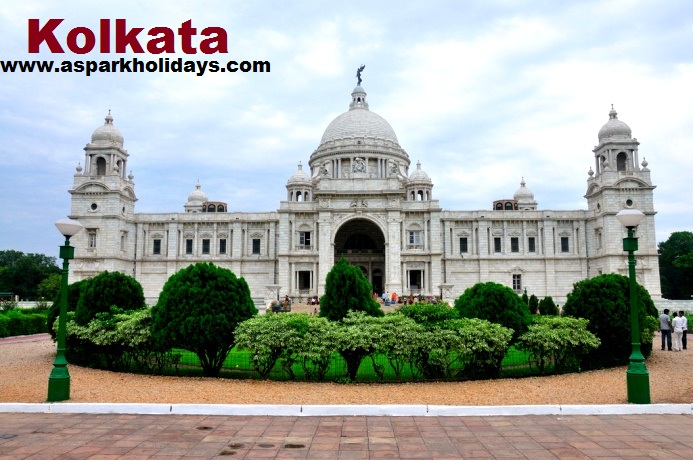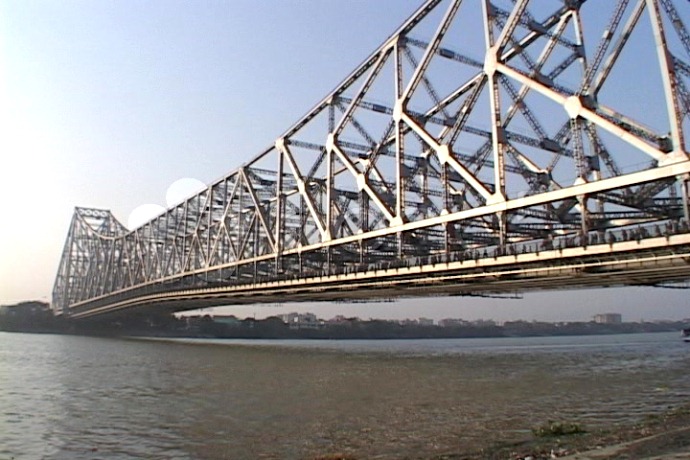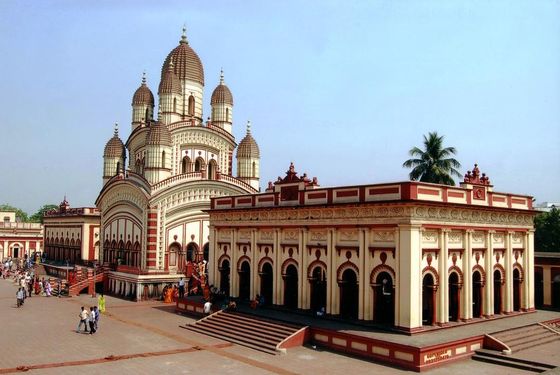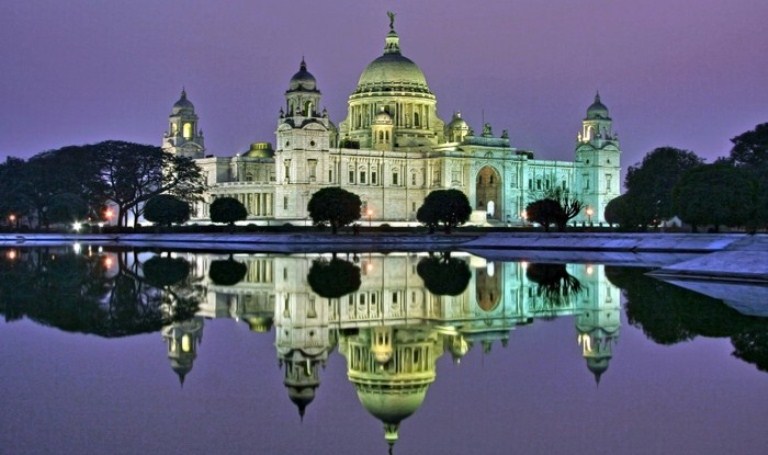
Kolkata is located at 22.82 degree North; 88.20 degree East. It is spread on the banks of Hooghly River and has an elevation of 30 feet. The total area of Kolkata is 1886 square kilometres. The Sundarbans delta separates Kolkata from the Bay of Bengal.
The city is divided into various topographical regions and five units namely the west, east, south, north and central Kolkata. The regions adjoining the city are Hooghly, Howrah, south 24 Parganas, North 24 Parganas and Nadia.
Visitors need to take a look at the maps to know the exact location of the city and its vast area to reach the destination quickly. Hooghly River flows for around 15 kilometres along the western part of Kolkata. Kolkata is the second largest city in India. It is a cosmopolitan city as over the years people from various cultures, states and religions have made Kolkata their home. Kolkata offers enormous opportunities in various fields like technology, industry, education, tourism, among-st others.
Some famous religious places located in the city are St. Thomas Church, Jain Maniktala, Jain Belgachhiya, Gurudwaras, and many more. There are plenty of hotels all over Kolkata ranging from the budget to the luxury. The Hyatt Regency, ITC Sonar, Oberoi Grand, The Golden Park, Hindustan international and the Ashoka are a few prominent hotels.
The language spoken here is mostly Bengali; the other languages spoken are Hindi, English and a few others as well. People of all religion reside in Kolkata including Hindus, Muslims, Sikhs and Christians.
History of Kolkata- The capital of British India is not as old as that of Delhi. The city finds mention as a 'Khas Mahal' or 'Imperial Jageer' in Ain-E-Akbari, compiled by Abdul Fazl, Prime Minister of Akbar. Savarna Ray Chowdhuri family had the Zamindari rights. Sutanati, Govindpur, and Kalikata were three villages which Job Charnok, an agent of the East India Company chose to establish British trade settlement. Prince Azim-us-Shan, grandson of Aurangzeb persuaded Savarna Ray Chowdhuri family to transfer the zamindari rights of these three villages to the East India Company. The English Settlement was ransacked by Siraj-ud-Dowla, in 1756 but was reclaimed by Robert Clive in 1757 after the battle of Plassey (originally Palashir -a place famous for jungle of Palash flowers -the flame of the jungle). Systematically the Company built up its power base and fortifications of the city of Calcutta and audaciously grew in political stature.
Kolkata was the capital of the country during British Rule and was then the second largest city of the British Empire only next to London.
Between 1820 and 1930, seeds of nationalism started growing and the nationalist movement reached its height under Indian leadership when people stood against the British rule.
Tourist Destinations in and around Kolkata- There are innumerable places that are of interest to tourists. The old building structure of the British Raj is still a very admirable work. Some must see attractions are :
Salt lake stadium- is the second largest stadium in the world with a seating capacity of 85000.
The Victoria memorial- is stunningly beautiful monument made of white marble built between 1906 -1921 to commemorate Queen Victoria in India.
Marble Palace- is a grand and extravagant mansion built in 1835 by Raja Rajendra Mullick. It continues to be a residence for his descendants,
Eden Garden cricket Stadium- established in 1864, is one of the most iconic stadiums in the world.
Esplanade- refers to a long, open, stretch, typically beside the sea, used for pleasure walks. Kolkata Esplanade In olden days, stretched from Dhurmotollah (now Lenin Sarani) to Chandpal Ghat on the Hooghly River.
Park Street- is a prominent attraction of Kolkata and boasts of beautiful Colonial buildings to bustling shopping outlets. This stretch has rightly been nicknamed as 'Food Street' and 'The Street that Never sleeps'. Clean and well maintained and dotted with many Colonial buildings every corner of this street is picture-perfect.
The Alipore Zoological Garden - or Kolkata Zoo is India's oldest Zoo, laid open in 1876.
Botanical Garden - Founded in 1786, the 109-hectare Botanical Garden is a great place to escape from the frazzling sounds and smells of the city. 250-year-old 'world's largest banyan tree' is the most touted attraction of the park.
Howrah Bridge - This cantilever bridge with a suspended span over River Hoogly is a famous symbol of Kolkata. It is the sixth-longest bridge of its kind in the world. Renamed as Rabindra Setu, it links the two cities of Howrah and Kolkata.
Writers' Building - One of the major land mark of city of joy and a must see tourist destination in Kolkata, Writers' Building is famous for its stunning architecture and design. Until around 1830, Fort William College used it as a camp for training writers in languages like Hindi and Persian. Today the building houses office of the State Government of West Bengal.
Indian Museum - the largest and oldest museum in India (1814) and also one of oldest museums in the world, this museum boasts of rare collections of antiques, armours, paintings, ornaments, mummies, skeletons, fossils among other things.
Jorasanko Thakur Bari - built in 1785 is the ancestral home of Rabindranath Tagore. Now also known as Tagore museum, it is dedicated to the life and works of the Nobel Laureate and the Bengal Renaissance. Spread over an area of 35000 sq m, it houses the Rabindra Bharati University.
The National Library of India - Lord Curzon, Governor General of India merged the collection of Calcutta Public Library (Established in 1836 ) with that of the Imperial Library (founded in 1891 ) making it the largest library in India. After Independence the Government of India changed the name of the Imperial Library to the National Library which houses a collection of more than 2.2 million books.
Fort William - now under the authority of the Indian Army was built during the early years of the Bengal Presidency of British India on the eastern bank of River Hoogly. The fort built of brick and mortar and shaped as an irregular octagon has a big Maidan which is the largest urban park in Calcutta.
Belur Mutt - founded by Swami Vivekananda, a chief disciple of Ramakrishna Paramahamsa is the head-quarter of the Ramakrishna Math and Mission. It is notable for its architecture and as a symbol of unity of all religions. Ramakrishna Movement or Vedanta Movement aims at harmony between religions, harmony of the ancient and the modern, spiritual fulfilment, all-round development of human faculties, peace for all humanity and social equality without any distinctions of caste, creed, race or nationality.
Birla Mandir - this magnificent temple built by the industrialist Birla family in cream-coloured sandstone and white marble is dedicated to lord Vishnu and his wife Lakshmi. Its three corn-cob shaped towers and the huge courtyard make it one of the finest architectural beauties of the city. GD Birla Sabaghar, state-of-the-art auditorium adjacent to the temple complex often hosts musical programs and other performances.
Dakshineswar Kali Temple - located in Dakshineswar near Kolkata is dedicated to Bhavatarini, an aspect of Kali Maa. This architectural treasure with towering height of more than 100 feet It is one of the most famous, most revered and sacred temples in India and one of the biggest in Kolkata.
St. Paul's Cathedral - famous for its Christmas midnight mass is not only a religious site but also an architectural wonder. With vertical piers and pointed arches showcasing Indo-Gothic architecture, its flagstaff rises to a height of 175 feet above ground level. The Cathedral is surrounded by huge grounds and adorned with several ancient trees.
Shaheed Minar - this 48 metre high monument formerly known as the Ochterlony Monument, was erected in 1828 in memory of Major-general Sir David Ochterlony, commander of the British East India Company. It got its new name 'Shaheed Minar' (Martyr's Tower) in 1969, in honour of Indian freedom fighters. 218 steps lead to the top of the monument from where one can savour a bird's eye view of Kolkata.
South Park Street Cemetery - Today, it is no longer in use and is a heritage site protected by the Archaeological Survey of India (ASI). The 1600 odd tombs and memorials are done up in gothic and Indo-Saracenic styles showcasing an imposing architecture replete with fine details and epitaphs of people gone by. The cemetery holds historical importance and though it is believed to be haunted is visited by many every day.
Science City Complex- this iconic institution comprising Space Odyssey, Dynamotion, Evolution Park - Theme Tour, Maritime Centre, Earth Exploration Hall and a sprawling Science Park is the largest science center in the Indian subcontinent. Inaugurated in 1997, it portrays the growth of science and technology and its application in human and environmental welfare.
The Birla Planetarium or 'Taramandal' - is a single storeyed circular structure styled on the Buddhist Stupa at Sanchi. It has been recognized as the largest planetarium in Asia and the second largest in the world. Flocked, especially by astronomy lovers, the Planetarium holds sky-shows mesmerising people to the grandeur of the night sky, the mysteries of the cosmos, evolution of earth and various concepts of astronomy.
Shopping in Kolkata- Shopping in culturally rich Kolkata can be fun. The vibrant markets are full of colour, sounds and the tantalizing aroma of food. Gariahat Market is a hub of handloom sarees, Bengali cotton sarees as well as traditional silk sarees. Curios, toys and fashion accessories, handmade bangles and necklaces, carved statues of wood and hand-made brassware, terracotta wares- especially the attractive decorative wall plaques in unique traditional designs can be seen on Chowringhee Road. Sovabazaar is the place to go for traditional Bengali shopping. Mallick Flower Market, the biggest flower market in all of Asia is a feast for the eyes.
Transport in Kolkata / How to Reach Kolkata- The transport system in Kolkata is a mixture of the old and the modern. The city is well connected to the rest of the country as well as the world. It has a good network of roads and national highways, where you see lots of cars, buses, taxis and also auto rickshaws. Kolkata is famous for its tram network. It is also the only city that has trams. Rickshaws pulled by men are also a common sight here. The fares are reasonable and are good for short distance use only.
Kolkata Metro is a very convenient mode of travel and is used by millions of people to travel from one part of the city to the other. It is trusted by locals as well as the tourists. It is an underground railway network, which is the first one in India. It begins from Dum Dum in the north and continues to go to Park Street and the Esplanade and further onto Tollygunge in the south. Ongoing tunnelling work under the Hooghly River is the first underwater project in the country, to provide metro connectivity between Howrah and Kolkata.
For visitors it is better to carry a map and follow the routes of the metro as it can take you to places like Shyam Bazar, Belgachia, Chandni Chowk, Rabindra Sadan, Netaji Bhavan, Jatin Das Park, central, Girish Park, Mahatam Gandhi road and Shova Bazar.
The Netaji Subhas Chandra Bose International Airport is to the north of the city and was earlier known as Dum Dum airport. It is situated around 17 km from the city center. Various flights take off to various cities in India and also to the other parts of the world.
By Air:- Netaji Subhash Chandra Bose International Airport situated at Dumdum, about 17 kilometres away from the heart of the city has good connectivity across major cities in India and abroad. Take a bus or hire a taxi from the airport to your final destination. Volvo buses also ply on multiple routes.
By Train:- Kolkata is well linked to cities across the country. Super-fast trains, Rajdhani and Shatabdi connect Kolkata to Delhi and nearby places. Howrah and Sealdah are the two major railway stations in the city.
By Road:- Kolkata is well connected with most Indian cities by road through National Highway number 2 and 6. Kolkata also has a broad network of government and private buses. The Calcutta State Transport Corporation (CSTC), Calcutta Tramways Company (CTC) and West Bengal Surface Transport Corporation (WBSTC) run buses in the city. The Esplanade Terminus in the heart of the city is the main bus terminus.
By Sea:- The Port of Kolkata is a riverine port, located around 203 kilometres from the sea. It is the oldest operating port in India, and was constructed by the British East India Company.
Need Aspark Help?
For Tour Packages, Vehicle Rental and Customer Care Support.
+91 9999 31 7846
booking@asparkholidays.comWhy Travel with Us?

Excellent Support
Our Team Available 24x7 for Customer support
Best Price & Savings
We Offer the Most Competitive Prices.



